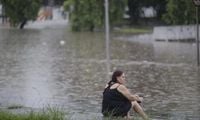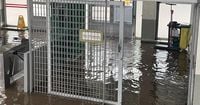On the afternoon of March 31, 2025, Greater São Paulo was struck by a powerful rainstorm, causing significant disruptions and damage, particularly in the Southeast region and the ABC Paulista area. The deluge led to severe flooding, with images circulating on social media showcasing hailstorms and the Celso Daniel train station in Santo André submerged under water.
The train station, part of the CPTM's Linha 10 (Turquesa), experienced operational challenges due to flooding on the tracks, which resulted in a suspension of train services between the Prefeito Celso Daniel-Santo André and Mauá stations. Reports indicated that the rain was so intense that it caused a house to collapse in Jardim Zaíra, Mauá, although fortunately, there were no injuries.
By 14:47, the Civil Defense of São Paulo had issued a "severe alert" for residents in the affected areas, warning of high risks for flooding and landslides. The alert urged residents to stay in safe locations as the storm intensified. In Santo André, Avenida dos Estados was rendered nearly impassable due to the overflow from the Tamanduateí River, while flooding was also reported in the Guarara stream and the Corumbé River.
According to the State Civil Defense, Mauá received an astonishing amount of rainfall, measuring the equivalent of what would typically fall over 18 days in just six hours. In Santo André, the precipitation accounted for 42% of the monthly average expected for March.
As the day progressed, the intensity of the rainfall began to diminish, and the city managed to exit a state of flooding by the end of the afternoon, as reported by the Center for Emergency Management (CGE). However, the damage had already been done, with approximately 79,600 customers left without power in Greater São Paulo, as confirmed by the utility company Enel.
In addition to the flooding, the storm caused significant disruptions to transportation. Train services on the CPTM's Linha 10-Turquesa were halted at around 14:50, and services on Linha 7-Rubi were limited to operations between the Botujuru and Jundiaí stations due to flooding issues. To assist stranded passengers, thirty buses from the Emergency Transport Support Plan (Paese) were deployed to transport individuals through the affected areas.
In Mauá, the downpour recorded in the last three hours reached 131 mm, while Santo André and São Bernardo do Campo reported rainfall totals of 84 mm and 52 mm, respectively. The Civil Defense issued severe alerts for these municipalities and for São Caetano as well.
Looking ahead, the forecast for the first week of April suggests a continuation of unsettled weather, with expectations of sun interspersed with clouds, high humidity, and further rain showers likely to occur in the late afternoons. On April 1, temperatures are expected to rise, ranging from a minimum of 20°C to a maximum that could exceed 29°C, with showers anticipated to return between mid-afternoon and evening.
This summer has already been particularly deadly, with 23 fatalities attributed to rain-related incidents in the state of São Paulo, according to the latest updates from the Civil Defense. Since December, a total of 173 cities have been affected by the storms, with 62 individuals reported injured and one person still missing.
The heavy rains have raised concerns among authorities about the potential for further flooding and landslides in the coming days, especially given the already saturated ground conditions. As emergency services continue to monitor the situation, residents are being urged to remain vigilant and prepared for possible evacuations if conditions worsen.
As the situation develops, local officials and emergency management teams are working tirelessly to assess damage and provide assistance to those affected by the storm. The community's resilience will be tested in the coming days as they navigate the aftermath of this severe weather event.






